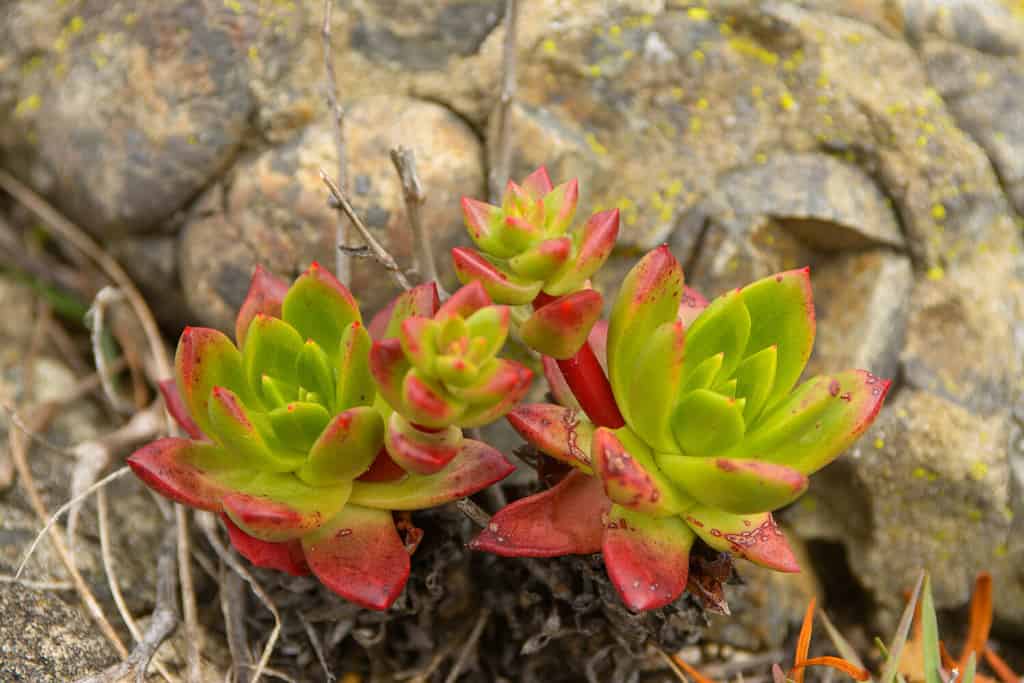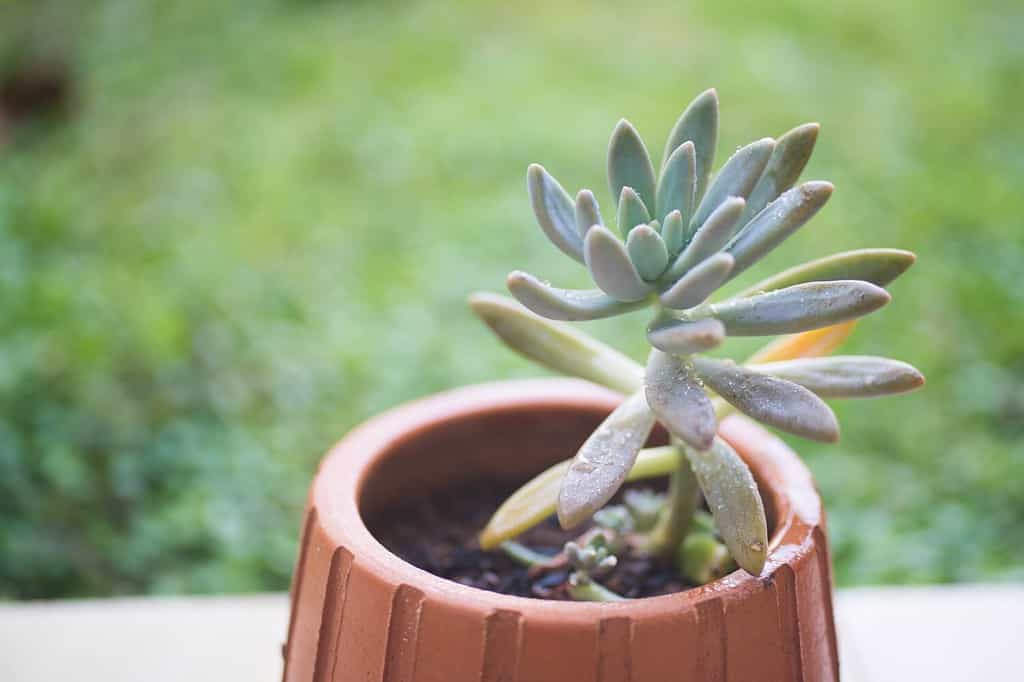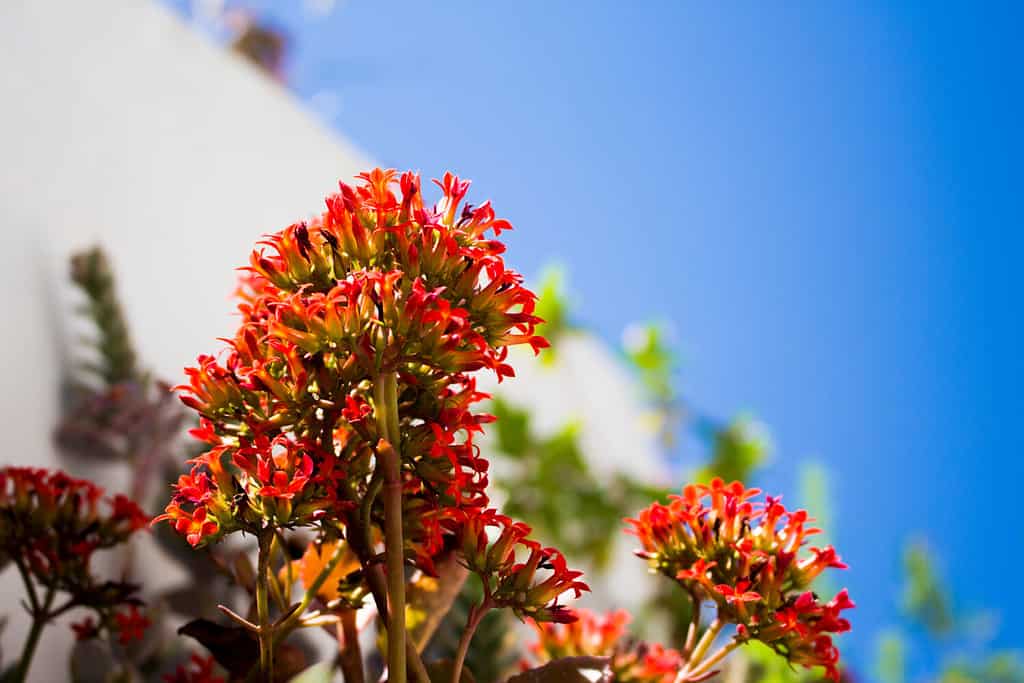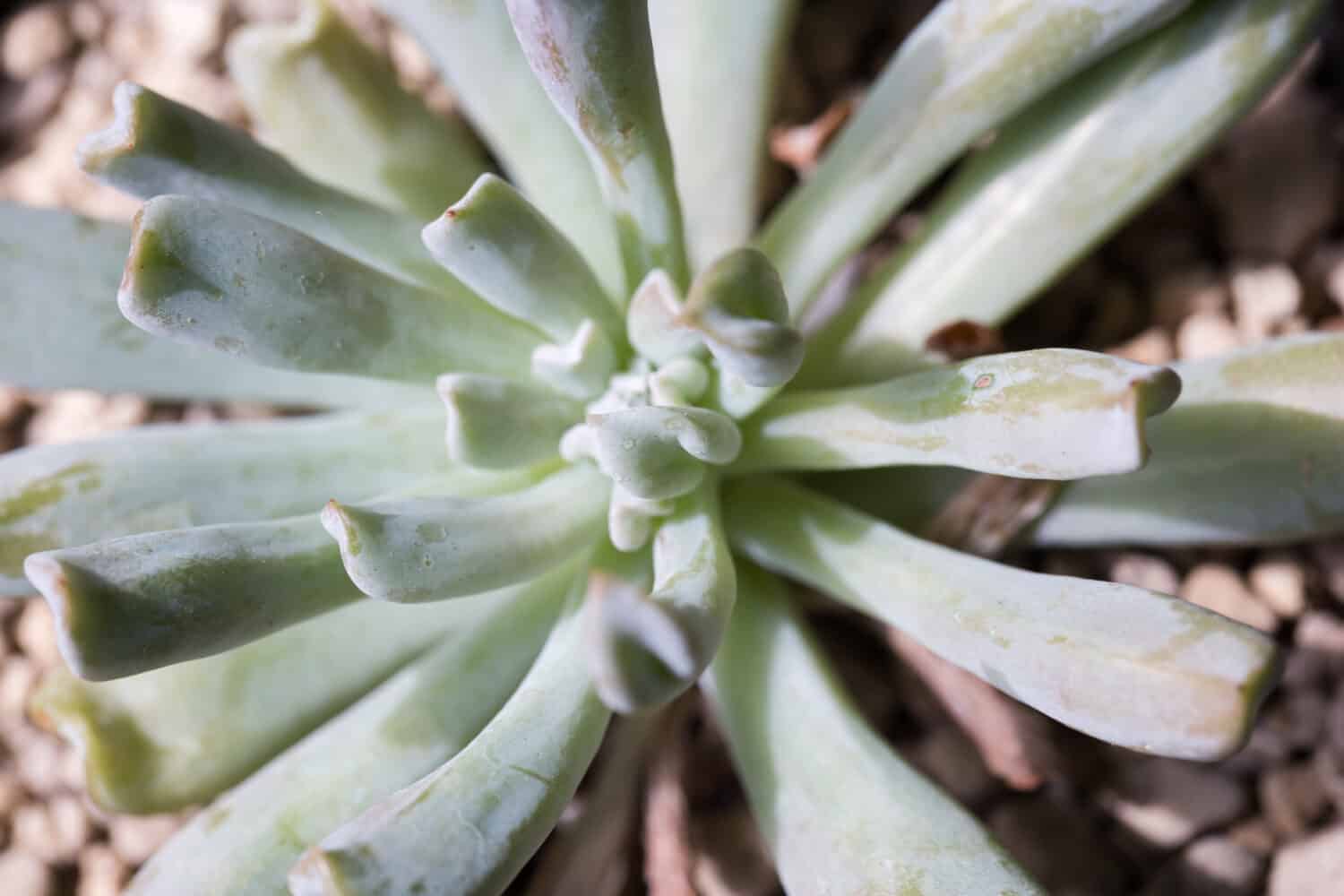There are seemingly endless types of succulents, each with its own unique characteristics and charm. While the Dudleya succulent isn’t spoken of as often as more popular types, like the echeveria, these cultivars are a worthy addition to any collection.
In this article, we’ll talk about the different types of dudleya succulents and how to care for them for optimal results.
Let’s dig in!
Dudleya Succulents: Origins
The Dudleya genus of succulents contains several subgenera, many species, and even more cultivars and varieties.
Botanists originally classified these succulents as a part of the Cotyledon genus. It was later reclassified as a Sedum, and then again as an Echeveria over the 1800s. It wasn’t until further studies in the 1940s that the Dudleya earned its own distinction.
The new genus was named after William Russel Dudley, the first-ever head of Botany at Stanford University.
These enduring succulents have another common name: liveforevers. With proper care and ideal conditions, some Dudleya species can live up to 100 years. However, plant poaching is a significant threat.
As succulents become more popular, poachers are taking plants from their natural environments (primarily California) to sell them. Californian conservationists are hard at work to protect these plants from poachers.
The California Native Plant Society was instrumental in passing legislation to criminalize poaching in 2021. Breaking the law could result in $500,000 in fines and a prison sentence.
Dudleya Succulents: Appearance
The Dudleya genus is diverse, with many unique species boasting unique qualities. However, there are a few shared characteristics to help you identify members of this genus.
- Lanceolate or spoon-shaped leaves – these succulents tend to have sharp, tapered leaves.
- Coloration – while colors can vary from species to species, most of these succulents have green leaves with either a gray or blue hue.
- Epicuticular wax – these succulents produce a waxy coating to protect themselves from the sun and retain moisture in hostile environments. This sometimes adds a white hue to the plant.
- Resilience – these succulents often grow in barren or seemingly inhabitable environments.
- Summer dormancy – unlike most succulents, dudleya grows in the fall, winter, and early spring while going dormant in the summer.
Dudleya species vary in color, size, shape, and rosette formations. However, these key traits are consistent across most varieties.
Dudleya Succulents: Common Varieties
While there are potentially hundreds of varieties in this genus, these are the most well-known in their natural environment, among plant collectors, and to conservationists.
1. Dudleya brittonii

Giant chalk has a dusty, white coating.
©Jack N. Mohr/Shutterstock.com
The Giant Chalk is one of the most common varieties among landscapers and collectors. While it’s native to California, its reach extends into Northern Mexico.
This species grows 18-20 inches tall with a similar spread. It has a loose rosette with pointed leaves growing gently upward. The green tones are offset by its waxy coating, contributing to a muted gray-blue shade. This species is both deer and disease-resistant, making it popular in landscaping.
With proper care, the Giant Chalk will grow deep red stems, reaching skyward with delicate yellow flowers.
2. Dudleya farinosa

Bluff lettuce has stunning red edges.
©RelentlessImages/Shutterstock.com
Commonly known as Bluff Lettuce, this dudleya has compact rosettes that grow in clusters. Its powdery coating gives Dudleya farinosa an almost-white glow, contrasted by deep maroon edges on the exterior foliage.
With proper care, Bluff Lettuce will grow pink-red stems with yellow flowers. This species is a popular target for poachers.
3. Dudleya greenei

This unique Dudleya looks different on each of the islands it calls home.
©Rani Restu Irianti/Shutterstock.com
This rare Dudleya is endemic to the Channel Islands of California, where it grows along the cliffs. It has small gray-green leaves that are broader than many other members of the genus.
This species will grow pink-purple stems with white flowers. Botanists study this unique succulent for its variability within its natural environment. Reports indicate that this species looks a little different on each of the eight islands it calls home.
4. Dudleya edulis

looks like garlic scapes.
©Elena Rostunova/Shutterstock.com
Also known as fingertips or lady fingers, this Dudleya looks nothing like its relatives. Rather than tight-forming rosettes, Dudleya edulis grows upward in thin, tubular leaves similar to garlic scapes. With proper care, it will produce white, stellate flowers.
This species has a rich cultural history among the indigenous Kumeyaay tribe, who have long harvested and eaten Dudleya edulis in the wild.
5. Dudleya virens

Collectors love this Dudleya species.
©v_rachai/Shutterstock.com
Dudleya virens may look like a hybrid between Dudleya edulis and Dudleya farinosa, but it is its own species. Its thick, tubular fingers grow upward with a green-gray hue. With proper care, it will produce delicate yellow flowers.
This drought-resilient succulent is another favorite among collectors and landscapers.
6. Dudleya abramsii

has several subspecies.
©Sundry Photography/Shutterstock.com
One of the lesser-known succulents in this genus is the Dudleya abramsii or Abram’s liveforever. While it produces the waxy coating for a muted tone, the foliage underneath is a unique olive green, often with notes of brown and red.
With proper care, Abram’s liveforever will produce white or yellow flowers, depending on the subspecies.
7. Dudleya saxosa

This Dudleya extends as far as Arizona.
©mmalikbilal/Shutterstock.com
Dudleya saxosa has unique tentacle-like leaves in shades of muted green with hints of pink and purple. This likeness is exacerbated in the subspecies, Dudleya saxosa subsp. collomiae. With proper care, it will produce red flowers.
This resilient succulent can be found as far east as Arizona, making it one of the more well-traveled species.
8. Dudleya nesiotica
Dudleya nesiotica is considered the rarest Dudleya succulent. Like the Dudleya greenei, it’s endemic to the Channel Islands. However, you can only find this species on Santa Cruz Island within the archipelago. It’s rare enough that pictures are hard to come by.
It is a threatened species with plump, green-red stalks and foliage culminating with a white bloom at the top.
How to Care for Dudleya Succulents
Dudleya perform best as indoor plants. While they technically exist in USDA zones 5-11, most species are unique to California’s West Coast climate, tolerating both coastal humidity and arid conditions. Try planting outside this region at your risk.
1. Soil Selection
Dudleya requires a well-draining cactus soil that replicates its rocky, coastal environment. Like many succulents, this species is prone to root rot and overwatering.
Plant in a pot with plenty of drainage. Clay pots are preferable.
2. Watering
Water sparingly, allowing the soil to dry entirely, then give your Dudleya a deep soak.
While it seems counterintuitive, it’s best to water this succulent less during the summer (its dormant period).
3. Sun Exposure
Place your Dudleya in full sunlight for 6-8 hours per day. If you move this beauty outside, provide some shade during peak hours when the sun is directly overhead.
4. Maintenance and Care
Many Dudleya species are naturally disease and pest-resistant. However, mealybugs and spider mites may make an appearance.
Keep these pests away with a damp cloth and dish soap or a neem oil treatment.
5. Fertilization and Repotting
Dudleya are used to inhabitable environments and don’t need fertilizer, especially during their dormancy. However, refreshing the soil and repotting every two years is recommended.
How to Propagate Dudleya Succulents
There’s a common misconception that Dudleya succulents should be propagated in the spring. This confusion stems from the typical spring and summer active growing period. However, this succulent grows in the fall and winter, going dormant in the summer. Propagate in the fall, instead.
Some Dudleyas are resistant to cuttings, though this is the preferred propagation method for most species.
- Water your Dudleya a few days before propagating.
- Gently twist and pull a healthy leaf from the stem.
- Let the leaf rest in indirect sunlight in a dry area for 2-3 days.
- After the leaf has calloused over, dip the end in rooting hormone. This step is optional.
- Lay the cutting on top of cactus soil in a shallow dish, covering the dipped end.
- Spray the tray with mist and cover with plastic wrap.
- Place the tray in indirect sunlight, misting it regularly until roots are established.
- Once the cutting roots and shows signs of initial growth, transfer to a new pot.
What is the difference between Echeveria and Dudleya?
While Echeveria succulents and Dudleya succulents are quite similar, there are a few notable differences.
Echeveria have a shorter lifespan, ranging from 3-30 years, depending on the species. Their leaves tend to be shorter and more compact, often (not always) rounded at the ends. They have a lot of range in coloration and size and extend further south into Mexico and Central America.
Dudleya have a long lifespan, reaching up to 100 years. Their leaves are usually longer and more narrow with sharp ends. The waxy coating creates a muted color palette, and their range rarely leaves California.
Are Dudleya Succulents Toxic to Pets?
Dudleya are considered non-toxic and pet safe. However, it’s always a good idea to place your plants out of reach if you have curious critters at home.
Thank you for reading! Have some feedback for us? Contact the AZ Animals editorial team.








